CQUniversity BUSN20017 Term 2: Internal Communication Audit Report
VerifiedAdded on 2023/06/09
|8
|1839
|314
Report
AI Summary
This report analyzes the internal communication issues of The Data Solutions Company, identifying problems at the executive, supervisor, and sales support levels. The audit, conducted in response to recurring software malfunctions reported by clients, reveals a lack of effective communication between executives and franchise offices, supervisors and project teams, and unprofessional email practices. The report details the communication audit process, specific and general purposes of the audit, and quantifies the significance of each identified problem. The report proposes actionable steps to solve these problems, including in-house sessions for executives, the fragmentation of workgroups, and the appointment of Customer Relationship Managers. Finally, the report outlines the benefits of these communication improvements, such as increased customer retention and enhanced employee skills, and provides contact information for further assistance.
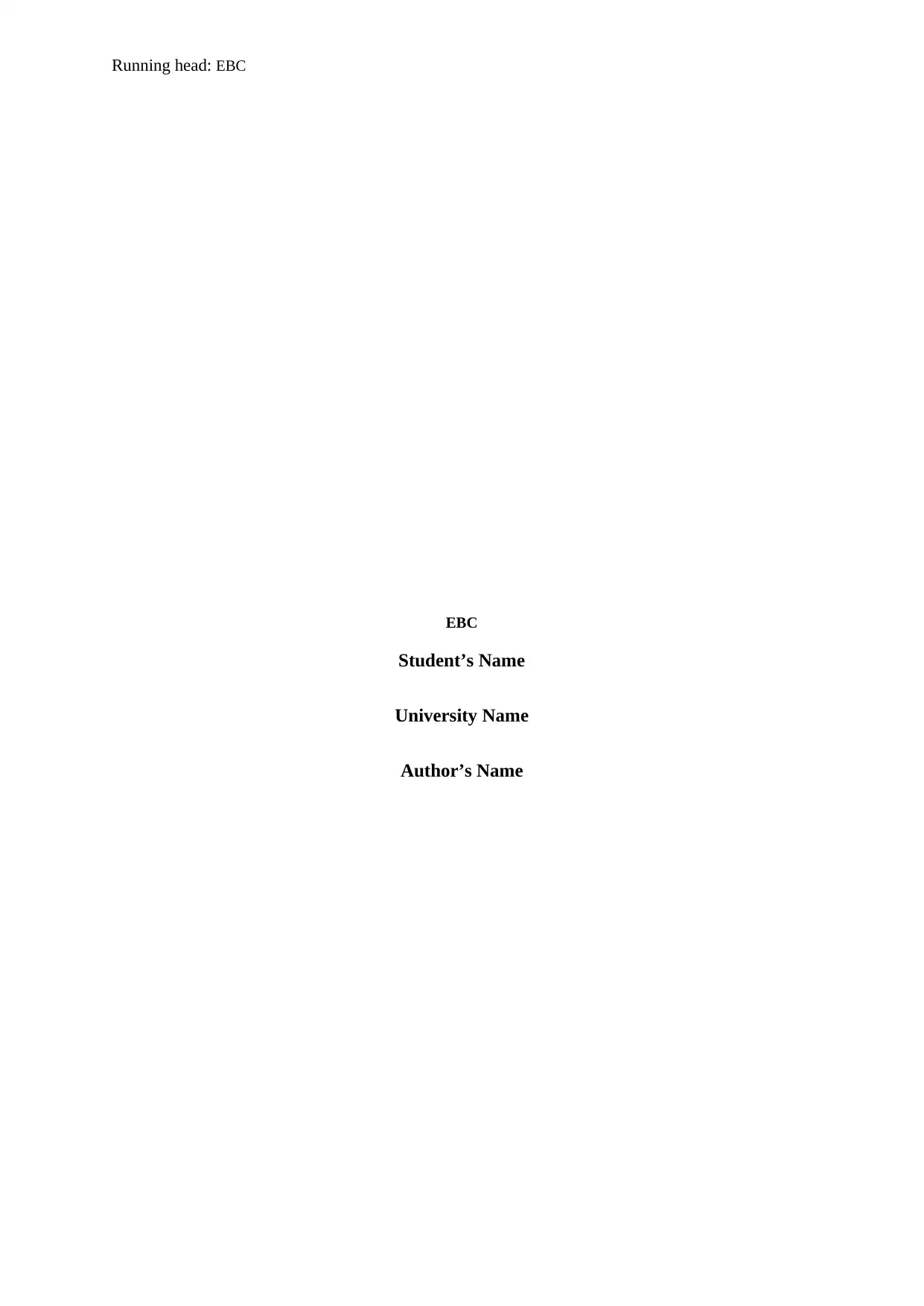
Running head: EBC
EBC
Student’s Name
University Name
Author’s Name
EBC
Student’s Name
University Name
Author’s Name
Paraphrase This Document
Need a fresh take? Get an instant paraphrase of this document with our AI Paraphraser
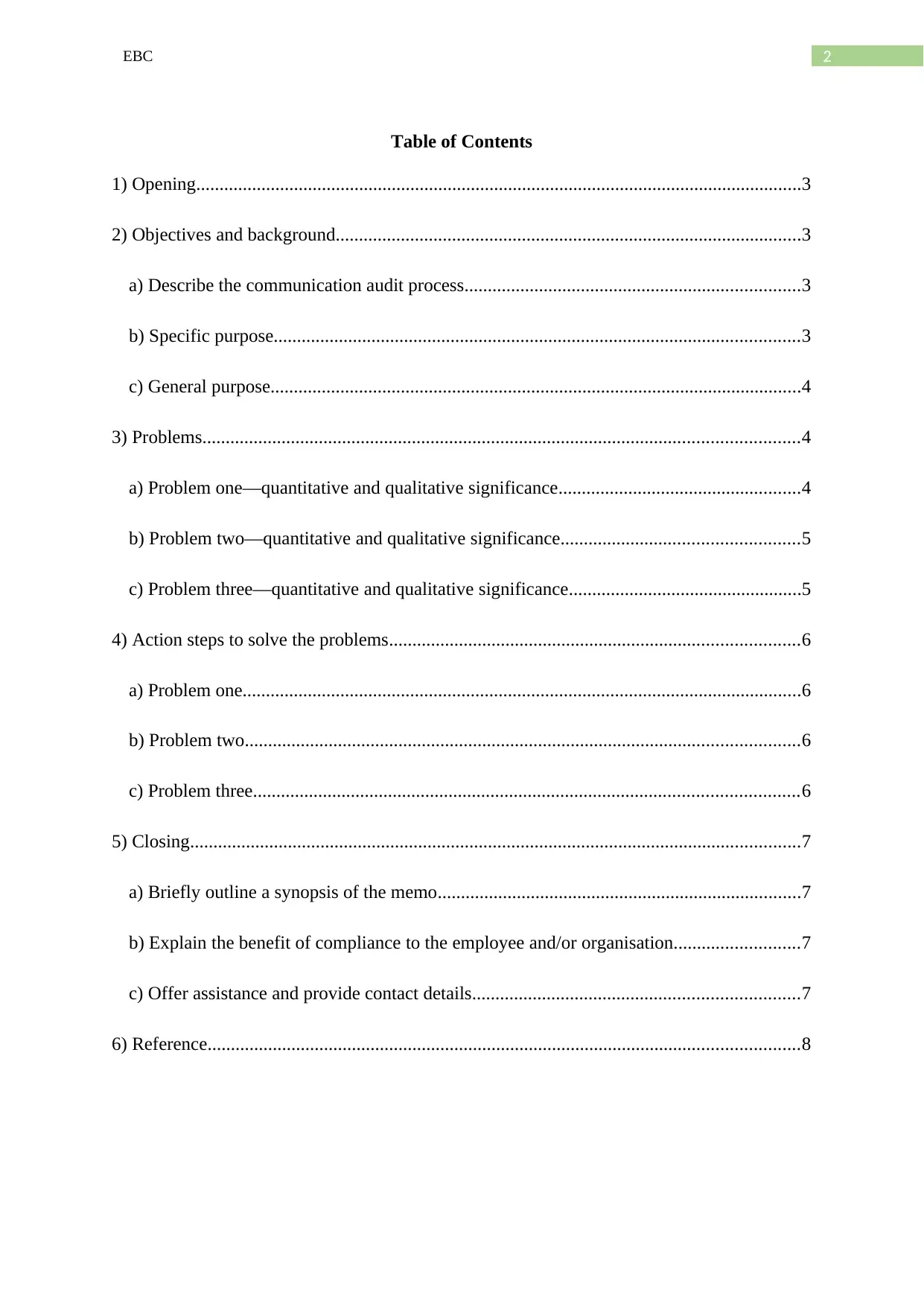
2EBC
Table of Contents
1) Opening..................................................................................................................................3
2) Objectives and background....................................................................................................3
a) Describe the communication audit process........................................................................3
b) Specific purpose.................................................................................................................3
c) General purpose..................................................................................................................4
3) Problems................................................................................................................................4
a) Problem one—quantitative and qualitative significance....................................................4
b) Problem two—quantitative and qualitative significance...................................................5
c) Problem three—quantitative and qualitative significance..................................................5
4) Action steps to solve the problems........................................................................................6
a) Problem one........................................................................................................................6
b) Problem two.......................................................................................................................6
c) Problem three.....................................................................................................................6
5) Closing...................................................................................................................................7
a) Briefly outline a synopsis of the memo..............................................................................7
b) Explain the benefit of compliance to the employee and/or organisation...........................7
c) Offer assistance and provide contact details......................................................................7
6) Reference...............................................................................................................................8
Table of Contents
1) Opening..................................................................................................................................3
2) Objectives and background....................................................................................................3
a) Describe the communication audit process........................................................................3
b) Specific purpose.................................................................................................................3
c) General purpose..................................................................................................................4
3) Problems................................................................................................................................4
a) Problem one—quantitative and qualitative significance....................................................4
b) Problem two—quantitative and qualitative significance...................................................5
c) Problem three—quantitative and qualitative significance..................................................5
4) Action steps to solve the problems........................................................................................6
a) Problem one........................................................................................................................6
b) Problem two.......................................................................................................................6
c) Problem three.....................................................................................................................6
5) Closing...................................................................................................................................7
a) Briefly outline a synopsis of the memo..............................................................................7
b) Explain the benefit of compliance to the employee and/or organisation...........................7
c) Offer assistance and provide contact details......................................................................7
6) Reference...............................................................................................................................8
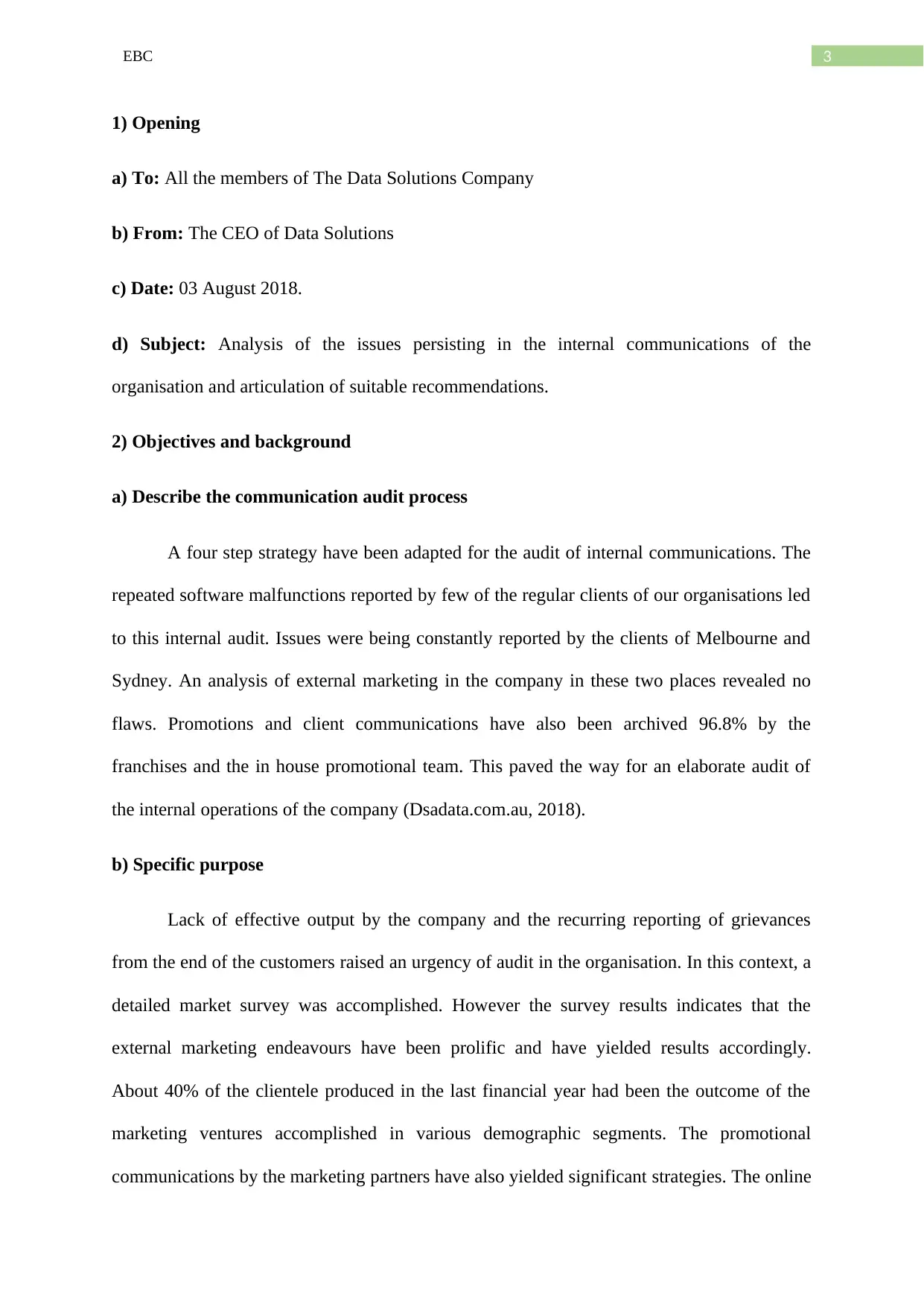
3EBC
1) Opening
a) To: All the members of The Data Solutions Company
b) From: The CEO of Data Solutions
c) Date: 03 August 2018.
d) Subject: Analysis of the issues persisting in the internal communications of the
organisation and articulation of suitable recommendations.
2) Objectives and background
a) Describe the communication audit process
A four step strategy have been adapted for the audit of internal communications. The
repeated software malfunctions reported by few of the regular clients of our organisations led
to this internal audit. Issues were being constantly reported by the clients of Melbourne and
Sydney. An analysis of external marketing in the company in these two places revealed no
flaws. Promotions and client communications have also been archived 96.8% by the
franchises and the in house promotional team. This paved the way for an elaborate audit of
the internal operations of the company (Dsadata.com.au, 2018).
b) Specific purpose
Lack of effective output by the company and the recurring reporting of grievances
from the end of the customers raised an urgency of audit in the organisation. In this context, a
detailed market survey was accomplished. However the survey results indicates that the
external marketing endeavours have been prolific and have yielded results accordingly.
About 40% of the clientele produced in the last financial year had been the outcome of the
marketing ventures accomplished in various demographic segments. The promotional
communications by the marketing partners have also yielded significant strategies. The online
1) Opening
a) To: All the members of The Data Solutions Company
b) From: The CEO of Data Solutions
c) Date: 03 August 2018.
d) Subject: Analysis of the issues persisting in the internal communications of the
organisation and articulation of suitable recommendations.
2) Objectives and background
a) Describe the communication audit process
A four step strategy have been adapted for the audit of internal communications. The
repeated software malfunctions reported by few of the regular clients of our organisations led
to this internal audit. Issues were being constantly reported by the clients of Melbourne and
Sydney. An analysis of external marketing in the company in these two places revealed no
flaws. Promotions and client communications have also been archived 96.8% by the
franchises and the in house promotional team. This paved the way for an elaborate audit of
the internal operations of the company (Dsadata.com.au, 2018).
b) Specific purpose
Lack of effective output by the company and the recurring reporting of grievances
from the end of the customers raised an urgency of audit in the organisation. In this context, a
detailed market survey was accomplished. However the survey results indicates that the
external marketing endeavours have been prolific and have yielded results accordingly.
About 40% of the clientele produced in the last financial year had been the outcome of the
marketing ventures accomplished in various demographic segments. The promotional
communications by the marketing partners have also yielded significant strategies. The online
⊘ This is a preview!⊘
Do you want full access?
Subscribe today to unlock all pages.

Trusted by 1+ million students worldwide
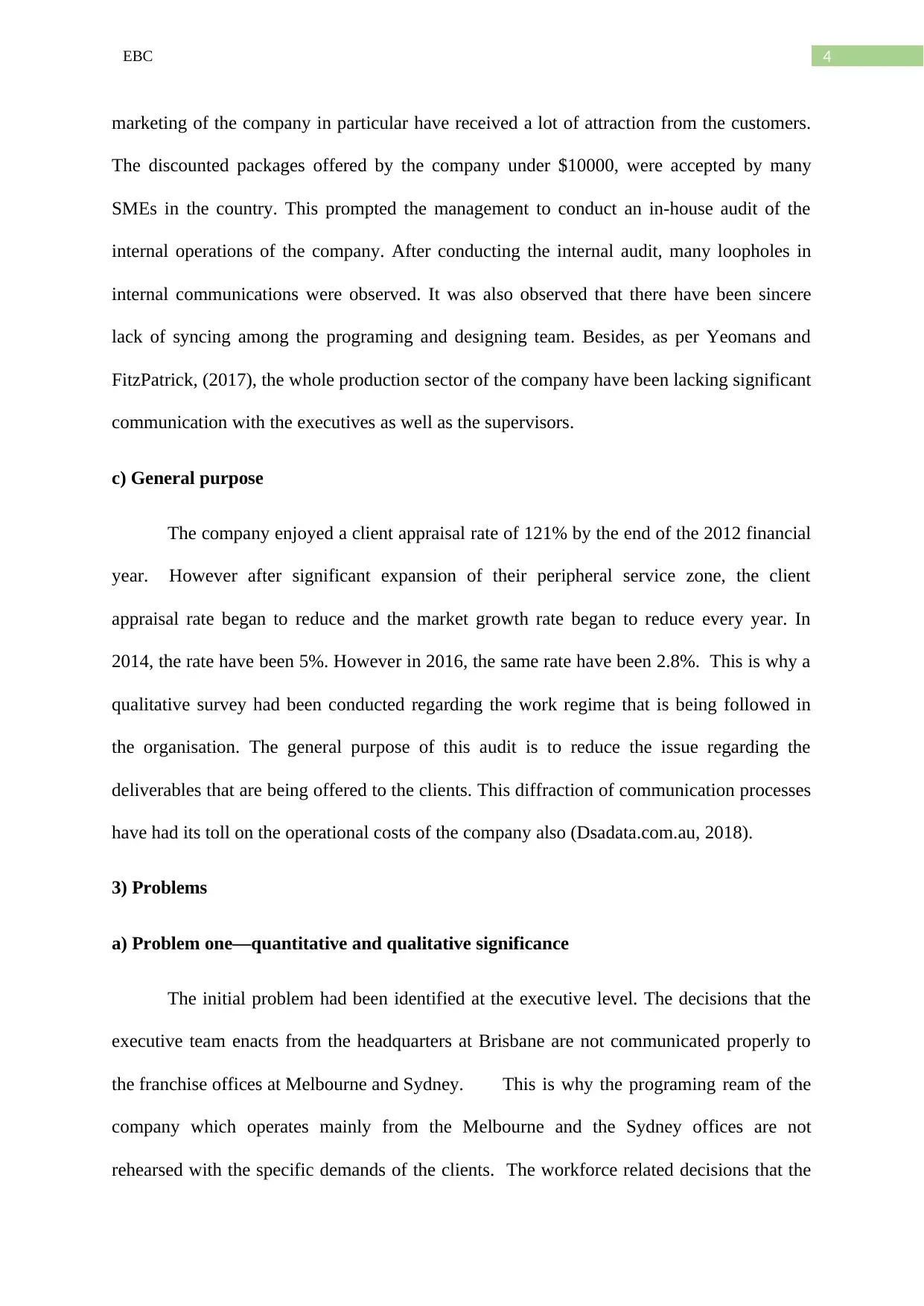
4EBC
marketing of the company in particular have received a lot of attraction from the customers.
The discounted packages offered by the company under $10000, were accepted by many
SMEs in the country. This prompted the management to conduct an in-house audit of the
internal operations of the company. After conducting the internal audit, many loopholes in
internal communications were observed. It was also observed that there have been sincere
lack of syncing among the programing and designing team. Besides, as per Yeomans and
FitzPatrick, (2017), the whole production sector of the company have been lacking significant
communication with the executives as well as the supervisors.
c) General purpose
The company enjoyed a client appraisal rate of 121% by the end of the 2012 financial
year. However after significant expansion of their peripheral service zone, the client
appraisal rate began to reduce and the market growth rate began to reduce every year. In
2014, the rate have been 5%. However in 2016, the same rate have been 2.8%. This is why a
qualitative survey had been conducted regarding the work regime that is being followed in
the organisation. The general purpose of this audit is to reduce the issue regarding the
deliverables that are being offered to the clients. This diffraction of communication processes
have had its toll on the operational costs of the company also (Dsadata.com.au, 2018).
3) Problems
a) Problem one—quantitative and qualitative significance
The initial problem had been identified at the executive level. The decisions that the
executive team enacts from the headquarters at Brisbane are not communicated properly to
the franchise offices at Melbourne and Sydney. This is why the programing ream of the
company which operates mainly from the Melbourne and the Sydney offices are not
rehearsed with the specific demands of the clients. The workforce related decisions that the
marketing of the company in particular have received a lot of attraction from the customers.
The discounted packages offered by the company under $10000, were accepted by many
SMEs in the country. This prompted the management to conduct an in-house audit of the
internal operations of the company. After conducting the internal audit, many loopholes in
internal communications were observed. It was also observed that there have been sincere
lack of syncing among the programing and designing team. Besides, as per Yeomans and
FitzPatrick, (2017), the whole production sector of the company have been lacking significant
communication with the executives as well as the supervisors.
c) General purpose
The company enjoyed a client appraisal rate of 121% by the end of the 2012 financial
year. However after significant expansion of their peripheral service zone, the client
appraisal rate began to reduce and the market growth rate began to reduce every year. In
2014, the rate have been 5%. However in 2016, the same rate have been 2.8%. This is why a
qualitative survey had been conducted regarding the work regime that is being followed in
the organisation. The general purpose of this audit is to reduce the issue regarding the
deliverables that are being offered to the clients. This diffraction of communication processes
have had its toll on the operational costs of the company also (Dsadata.com.au, 2018).
3) Problems
a) Problem one—quantitative and qualitative significance
The initial problem had been identified at the executive level. The decisions that the
executive team enacts from the headquarters at Brisbane are not communicated properly to
the franchise offices at Melbourne and Sydney. This is why the programing ream of the
company which operates mainly from the Melbourne and the Sydney offices are not
rehearsed with the specific demands of the clients. The workforce related decisions that the
Paraphrase This Document
Need a fresh take? Get an instant paraphrase of this document with our AI Paraphraser
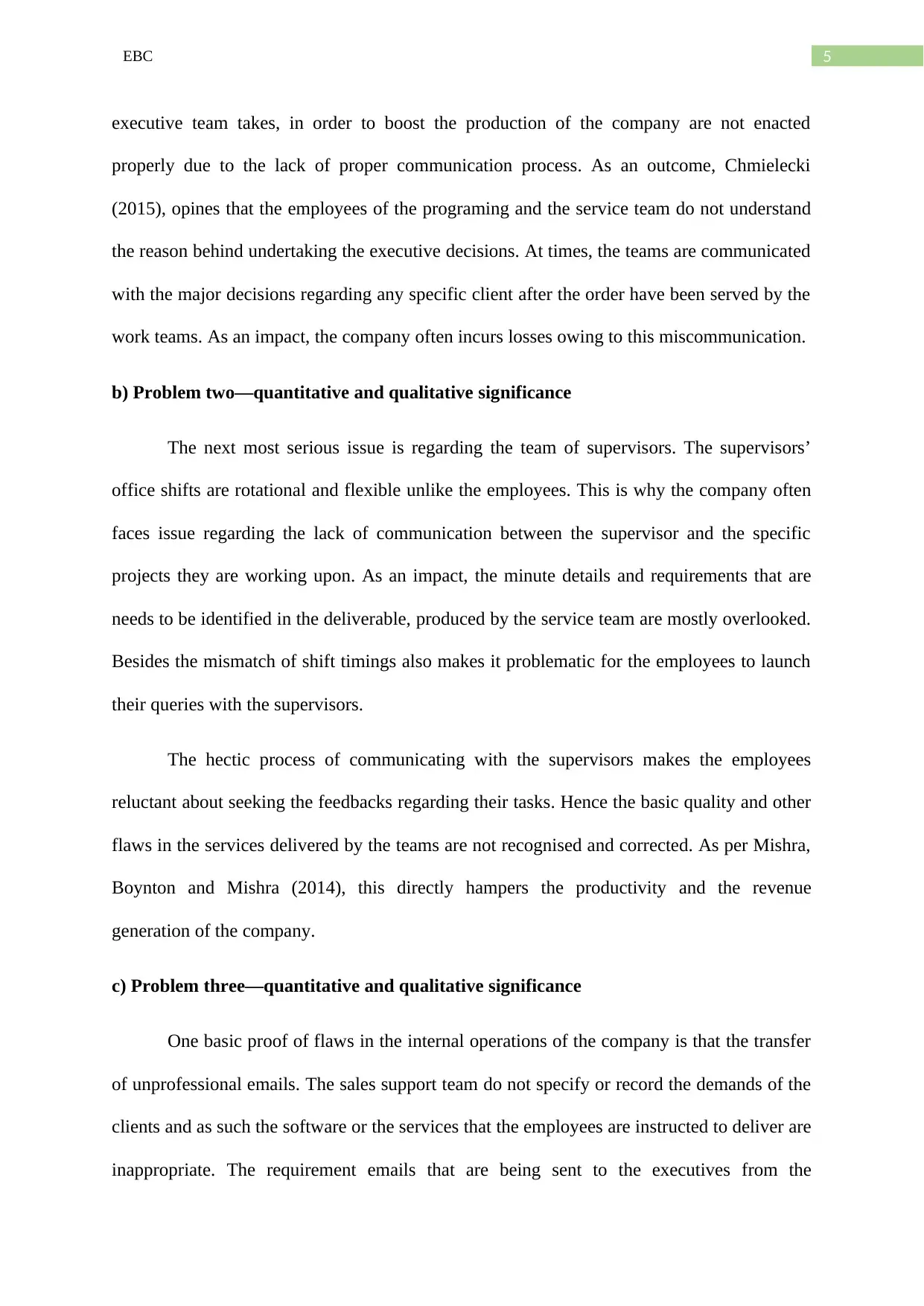
5EBC
executive team takes, in order to boost the production of the company are not enacted
properly due to the lack of proper communication process. As an outcome, Chmielecki
(2015), opines that the employees of the programing and the service team do not understand
the reason behind undertaking the executive decisions. At times, the teams are communicated
with the major decisions regarding any specific client after the order have been served by the
work teams. As an impact, the company often incurs losses owing to this miscommunication.
b) Problem two—quantitative and qualitative significance
The next most serious issue is regarding the team of supervisors. The supervisors’
office shifts are rotational and flexible unlike the employees. This is why the company often
faces issue regarding the lack of communication between the supervisor and the specific
projects they are working upon. As an impact, the minute details and requirements that are
needs to be identified in the deliverable, produced by the service team are mostly overlooked.
Besides the mismatch of shift timings also makes it problematic for the employees to launch
their queries with the supervisors.
The hectic process of communicating with the supervisors makes the employees
reluctant about seeking the feedbacks regarding their tasks. Hence the basic quality and other
flaws in the services delivered by the teams are not recognised and corrected. As per Mishra,
Boynton and Mishra (2014), this directly hampers the productivity and the revenue
generation of the company.
c) Problem three—quantitative and qualitative significance
One basic proof of flaws in the internal operations of the company is that the transfer
of unprofessional emails. The sales support team do not specify or record the demands of the
clients and as such the software or the services that the employees are instructed to deliver are
inappropriate. The requirement emails that are being sent to the executives from the
executive team takes, in order to boost the production of the company are not enacted
properly due to the lack of proper communication process. As an outcome, Chmielecki
(2015), opines that the employees of the programing and the service team do not understand
the reason behind undertaking the executive decisions. At times, the teams are communicated
with the major decisions regarding any specific client after the order have been served by the
work teams. As an impact, the company often incurs losses owing to this miscommunication.
b) Problem two—quantitative and qualitative significance
The next most serious issue is regarding the team of supervisors. The supervisors’
office shifts are rotational and flexible unlike the employees. This is why the company often
faces issue regarding the lack of communication between the supervisor and the specific
projects they are working upon. As an impact, the minute details and requirements that are
needs to be identified in the deliverable, produced by the service team are mostly overlooked.
Besides the mismatch of shift timings also makes it problematic for the employees to launch
their queries with the supervisors.
The hectic process of communicating with the supervisors makes the employees
reluctant about seeking the feedbacks regarding their tasks. Hence the basic quality and other
flaws in the services delivered by the teams are not recognised and corrected. As per Mishra,
Boynton and Mishra (2014), this directly hampers the productivity and the revenue
generation of the company.
c) Problem three—quantitative and qualitative significance
One basic proof of flaws in the internal operations of the company is that the transfer
of unprofessional emails. The sales support team do not specify or record the demands of the
clients and as such the software or the services that the employees are instructed to deliver are
inappropriate. The requirement emails that are being sent to the executives from the
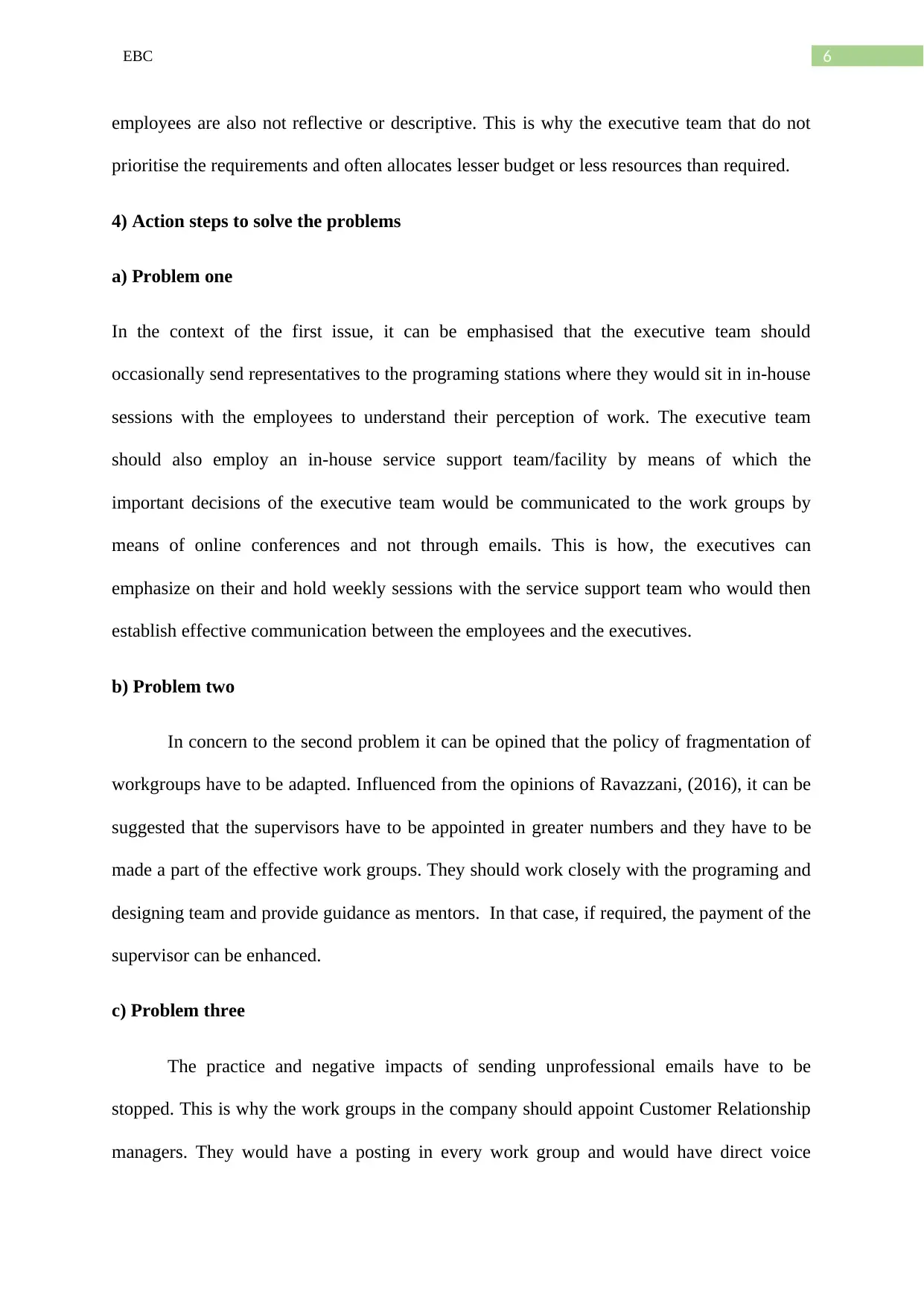
6EBC
employees are also not reflective or descriptive. This is why the executive team that do not
prioritise the requirements and often allocates lesser budget or less resources than required.
4) Action steps to solve the problems
a) Problem one
In the context of the first issue, it can be emphasised that the executive team should
occasionally send representatives to the programing stations where they would sit in in-house
sessions with the employees to understand their perception of work. The executive team
should also employ an in-house service support team/facility by means of which the
important decisions of the executive team would be communicated to the work groups by
means of online conferences and not through emails. This is how, the executives can
emphasize on their and hold weekly sessions with the service support team who would then
establish effective communication between the employees and the executives.
b) Problem two
In concern to the second problem it can be opined that the policy of fragmentation of
workgroups have to be adapted. Influenced from the opinions of Ravazzani, (2016), it can be
suggested that the supervisors have to be appointed in greater numbers and they have to be
made a part of the effective work groups. They should work closely with the programing and
designing team and provide guidance as mentors. In that case, if required, the payment of the
supervisor can be enhanced.
c) Problem three
The practice and negative impacts of sending unprofessional emails have to be
stopped. This is why the work groups in the company should appoint Customer Relationship
managers. They would have a posting in every work group and would have direct voice
employees are also not reflective or descriptive. This is why the executive team that do not
prioritise the requirements and often allocates lesser budget or less resources than required.
4) Action steps to solve the problems
a) Problem one
In the context of the first issue, it can be emphasised that the executive team should
occasionally send representatives to the programing stations where they would sit in in-house
sessions with the employees to understand their perception of work. The executive team
should also employ an in-house service support team/facility by means of which the
important decisions of the executive team would be communicated to the work groups by
means of online conferences and not through emails. This is how, the executives can
emphasize on their and hold weekly sessions with the service support team who would then
establish effective communication between the employees and the executives.
b) Problem two
In concern to the second problem it can be opined that the policy of fragmentation of
workgroups have to be adapted. Influenced from the opinions of Ravazzani, (2016), it can be
suggested that the supervisors have to be appointed in greater numbers and they have to be
made a part of the effective work groups. They should work closely with the programing and
designing team and provide guidance as mentors. In that case, if required, the payment of the
supervisor can be enhanced.
c) Problem three
The practice and negative impacts of sending unprofessional emails have to be
stopped. This is why the work groups in the company should appoint Customer Relationship
managers. They would have a posting in every work group and would have direct voice
⊘ This is a preview!⊘
Do you want full access?
Subscribe today to unlock all pages.

Trusted by 1+ million students worldwide
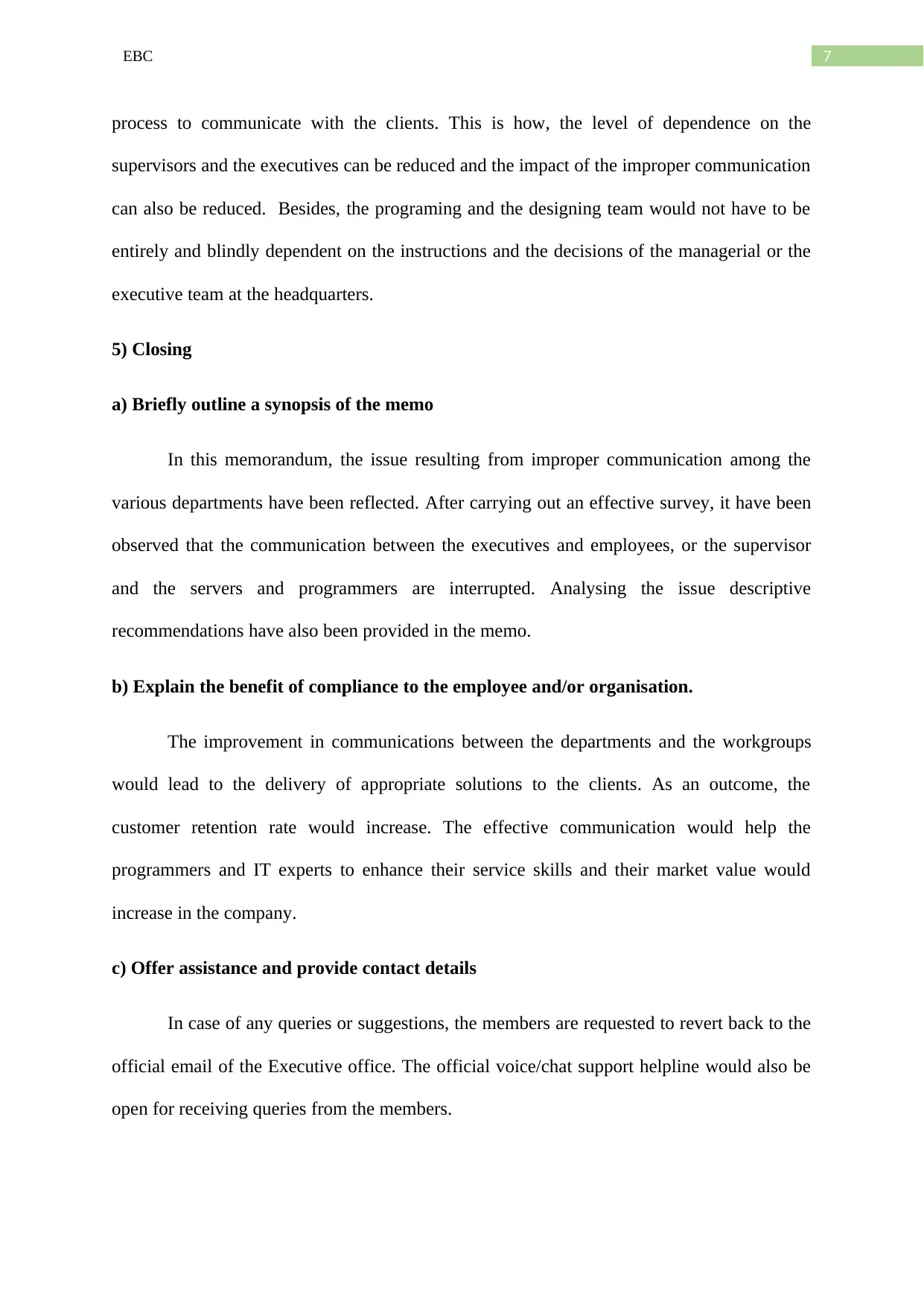
7EBC
process to communicate with the clients. This is how, the level of dependence on the
supervisors and the executives can be reduced and the impact of the improper communication
can also be reduced. Besides, the programing and the designing team would not have to be
entirely and blindly dependent on the instructions and the decisions of the managerial or the
executive team at the headquarters.
5) Closing
a) Briefly outline a synopsis of the memo
In this memorandum, the issue resulting from improper communication among the
various departments have been reflected. After carrying out an effective survey, it have been
observed that the communication between the executives and employees, or the supervisor
and the servers and programmers are interrupted. Analysing the issue descriptive
recommendations have also been provided in the memo.
b) Explain the benefit of compliance to the employee and/or organisation.
The improvement in communications between the departments and the workgroups
would lead to the delivery of appropriate solutions to the clients. As an outcome, the
customer retention rate would increase. The effective communication would help the
programmers and IT experts to enhance their service skills and their market value would
increase in the company.
c) Offer assistance and provide contact details
In case of any queries or suggestions, the members are requested to revert back to the
official email of the Executive office. The official voice/chat support helpline would also be
open for receiving queries from the members.
process to communicate with the clients. This is how, the level of dependence on the
supervisors and the executives can be reduced and the impact of the improper communication
can also be reduced. Besides, the programing and the designing team would not have to be
entirely and blindly dependent on the instructions and the decisions of the managerial or the
executive team at the headquarters.
5) Closing
a) Briefly outline a synopsis of the memo
In this memorandum, the issue resulting from improper communication among the
various departments have been reflected. After carrying out an effective survey, it have been
observed that the communication between the executives and employees, or the supervisor
and the servers and programmers are interrupted. Analysing the issue descriptive
recommendations have also been provided in the memo.
b) Explain the benefit of compliance to the employee and/or organisation.
The improvement in communications between the departments and the workgroups
would lead to the delivery of appropriate solutions to the clients. As an outcome, the
customer retention rate would increase. The effective communication would help the
programmers and IT experts to enhance their service skills and their market value would
increase in the company.
c) Offer assistance and provide contact details
In case of any queries or suggestions, the members are requested to revert back to the
official email of the Executive office. The official voice/chat support helpline would also be
open for receiving queries from the members.
Paraphrase This Document
Need a fresh take? Get an instant paraphrase of this document with our AI Paraphraser
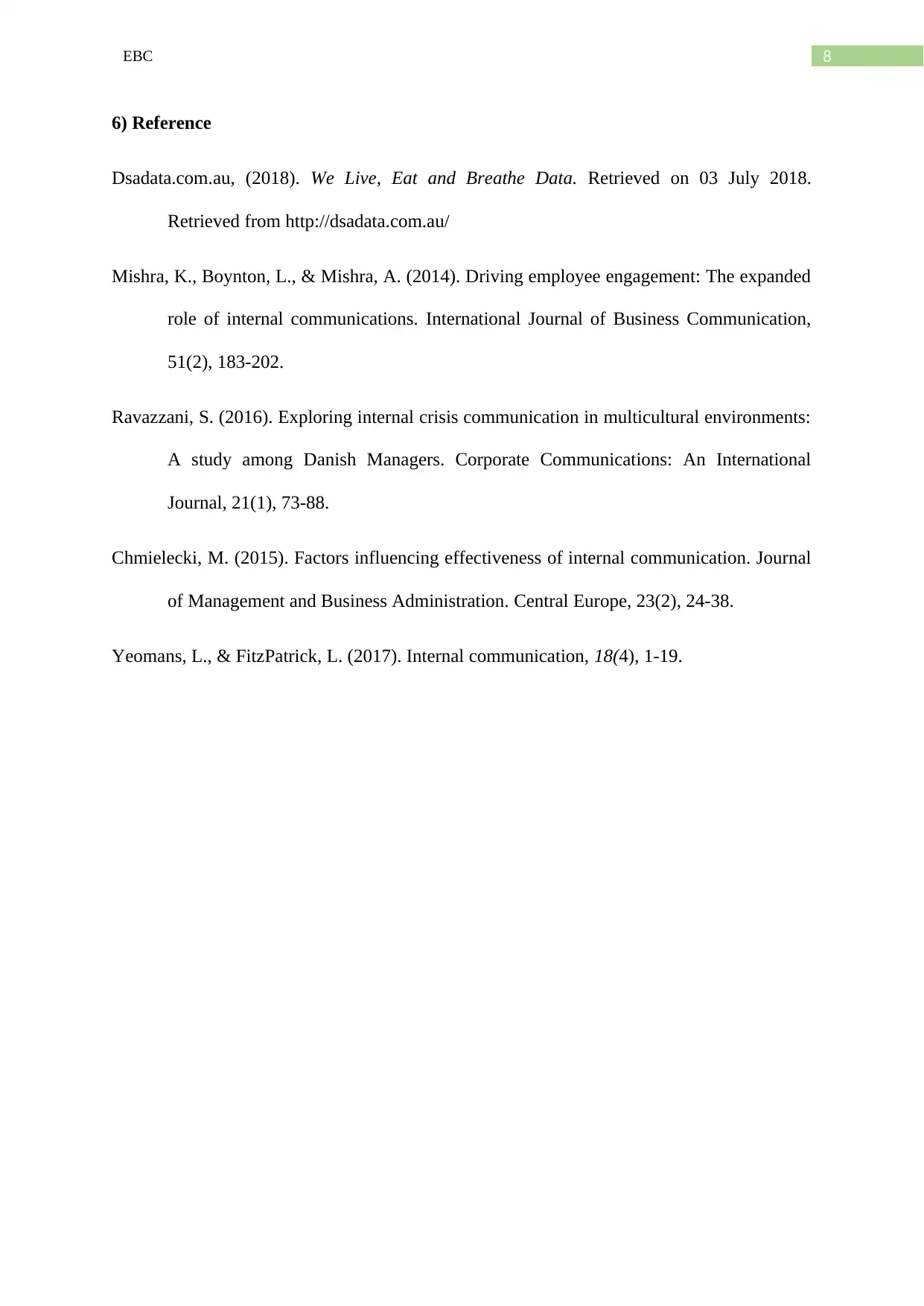
8EBC
6) Reference
Dsadata.com.au, (2018). We Live, Eat and Breathe Data. Retrieved on 03 July 2018.
Retrieved from http://dsadata.com.au/
Mishra, K., Boynton, L., & Mishra, A. (2014). Driving employee engagement: The expanded
role of internal communications. International Journal of Business Communication,
51(2), 183-202.
Ravazzani, S. (2016). Exploring internal crisis communication in multicultural environments:
A study among Danish Managers. Corporate Communications: An International
Journal, 21(1), 73-88.
Chmielecki, M. (2015). Factors influencing effectiveness of internal communication. Journal
of Management and Business Administration. Central Europe, 23(2), 24-38.
Yeomans, L., & FitzPatrick, L. (2017). Internal communication, 18(4), 1-19.
6) Reference
Dsadata.com.au, (2018). We Live, Eat and Breathe Data. Retrieved on 03 July 2018.
Retrieved from http://dsadata.com.au/
Mishra, K., Boynton, L., & Mishra, A. (2014). Driving employee engagement: The expanded
role of internal communications. International Journal of Business Communication,
51(2), 183-202.
Ravazzani, S. (2016). Exploring internal crisis communication in multicultural environments:
A study among Danish Managers. Corporate Communications: An International
Journal, 21(1), 73-88.
Chmielecki, M. (2015). Factors influencing effectiveness of internal communication. Journal
of Management and Business Administration. Central Europe, 23(2), 24-38.
Yeomans, L., & FitzPatrick, L. (2017). Internal communication, 18(4), 1-19.
1 out of 8
Related Documents
Your All-in-One AI-Powered Toolkit for Academic Success.
+13062052269
info@desklib.com
Available 24*7 on WhatsApp / Email
![[object Object]](/_next/static/media/star-bottom.7253800d.svg)
Unlock your academic potential
Copyright © 2020–2025 A2Z Services. All Rights Reserved. Developed and managed by ZUCOL.



